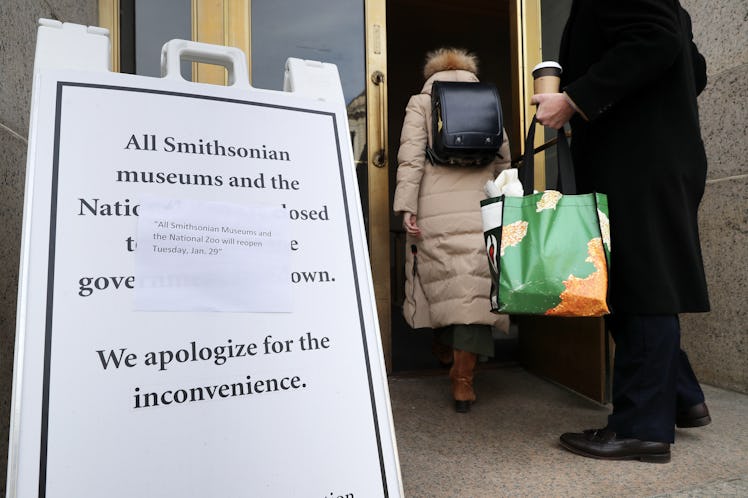
A Second Government Shutdown Could Be Really Bad News For A Few Reasons
It had only been two days since Congress passed legislation to end the partial government shutdown, and President Donald Trump was already talking about a second one. After the president and his counterparts made a deal on Friday, Jan. 25 to temporarily reopen the government, Congress now has until Feb. 15 to come up with a new plan that can appease the House, the Senate, and the president. So what happens if the government shuts down again?
A bipartisan group of lawmakers tasked with drafting new legislation to fund the government through the end of the fiscal year has just over two weeks to come up with a plan that will appease the House, the Senate, and the president. Trump, though he compromised on his key demand for $5.7 billion for a border wall in the negotiations that led to Friday's deal, has re-upped his demand for that funding after facing backlash from conservative pundits for what they saw as capitulating to Democrats.
In an interview with The Wall Street Journal on Sunday Jan. 27, Trump said that if a new deal to fund the government doesn't include that wall funding, he'd consider declaring a national emergency to circumvent Congress or refuse to sign the legislation altogether, forcing another shutdown less than a month after the first one ended.
Should that come to pass, it's all but certain that the 800,000 federal employees who were out of work on furlough or working without pay would be financially burdened once more. The 35-day shutdown left many struggling to pay bills, having to forego medication, skipping meals, or taking on temporary gigs to put food on the table after missing paychecks.
Though those 800,000 employees, as public servants, are eligible for backpay, The Washington Post reports that another million-plus contract workers, including whose who guard, care for, and clean federal facilities, are not. So for the lowest-paid workers who were out of a job for a month, there is no salary to be recouped, and a second shutdown would likely leave them scrambling to make ends meet on top of trying to recover from a major financial hardship.
In a Congressional Budget Office (CBO) report published Monday, the nonpartisan scorekeeper estimated that the cost to the U.S. economy for the month-long shutdown was about $11 billion dollars. While some $8 billion of that could eventually be recovered as employees receive backpay and go back to work, another $3 billion was lost forever. It may be a drop in the bucket for a large economy, but as the stories of workers' struggles showed, the financial costs were disproportionately borne by federal employees and agencies. Add another shutdown to this already-strained equation, and the casualties may not be so few.
What's more, the CBO's estimate was based on the idea that the nation will rebound if and when workers get back to a continued state of normalcy, where they can work and spend with the relative certainty of standard times. A second shutdown would throw a wrench in those gears and may send the economy lurching again. Markets and investors are reportedly already responding to the prospect of a Shutdown 2.0.
For the average American who isn't directly feeling the effects, there are still inconveniences. It's worth mentioning too that tax season officially opened on Jan. 28, and the next month will prove a busy one for the Internal Revenue Service (IRS) — one of the agencies affected by the shutdown. A second shutdown could potentially put a roadblock up at a time when millions of Americans will be filing their tax returns and awaiting refunds. And if a Shutdown 2.0 is anything like the last one, Americans could be facing more delays at major airports and closures of national parks and museums.
As for the federal workforce's future, a second shutdown would likely put a damper on it. Morale has already been low with five weeks of uncertainty and hardship for civil servants, as NPR reports, and the prospect of not getting paid and facing job insecurity hasn't exactly helped the federal government's recruitment efforts, especially now that it's become something of a trend. This last shutdown, which began Dec. 22, was the third in the 2018 calendar year, following one in January and another in February. Having a second shutdown take place in 2019 would likely not help assuage any concerns about the stability of the job for a workforce that needs more younger recruits.
In terms of political casualties, the clear winners and losers would largely depend on what goes down by Feb. 15. Though acting White House Chief of Staff Mick Mulvaney has said the president is prepared to go through with a second shutdown, polls recently showed that Americans mostly blamed Trump for the shutdown, and that his ratings fell among his base during the affair, so it's not clear that he'd want a do-over of this as his first choice of outcome. Meanwhile, Vanity Fair notes that plenty of GOP lawmakers are fully on board with Trump possibly declaring a national emergency, which would allow them to still get a wall without facing backlash for failing to pass legislation.
At this point, it's not clear what option the president might go with as Feb. 15 approaches. But a second shutdown is probably the last thing many Americans would want to see.